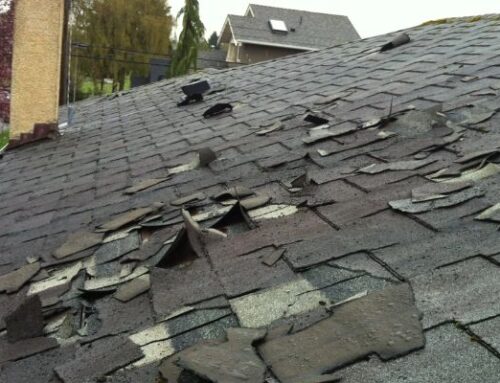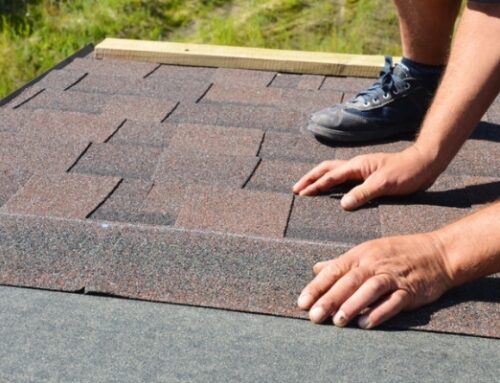Storms can wreak havoc on homes, particularly on the residential roof, which is often the first line of defense against severe weather conditions. High winds, hail, and heavy rain can cause significant roof damage, leaving homeowners scrambling to fix the issues quickly. This homeowner’s guide will walk you through the essential steps to take when dealing with storm damage to your roof, ensuring you know exactly what to do to protect your home and family. Here are 10 key aspects to consider:
1. Assessing Roof Damage Immediately After a Storm
- After a storm, the first step is to assess the extent of the roof damage. Look for visible signs such as missing shingles, dents, cracks, or debris on the roof and around the property.
- Be aware of specific types of damage like wind damage, which can lift or tear off shingles, and hail damage, which often appears as dents or pockmarks.
- Conducting a thorough roof inspection yourself can help identify any immediate threats, but always prioritize safety. If the damage appears severe or you feel unsafe, contact a professional.
2. Conducting a Professional Roof Inspection
- A detailed roof inspection by a licensed roofing contractor is essential to identify all the damage that may not be visible from the ground.
- Professional roofing services can detect hidden problems, such as underlying structural damage or leaks that could lead to further issues if not addressed promptly.
- Documenting all findings during this inspection will be crucial for insurance claims and roof repair planning.
3. Temporary Roof Protection Measures
- If your residential roof has been compromised, taking steps to apply temporary roof protection can prevent further interior damage from water leaks.
- Use tarps or plywood to cover exposed areas temporarily. This is especially important if a storm has caused punctures or removed a significant portion of the roofing material.
- Quick action can prevent water damage to the interior of your home and give you time to arrange for professional repairs.
4. Understanding Roof Insurance Claims
- Navigating roof insurance claims can be daunting, but understanding your policy is crucial for a successful claim.
- Review your homeowner’s insurance policy to determine what type of roof damage is covered, such as wind damage or hail damage.
- Document all damage with photos and detailed notes and file the claim as soon as possible. Keep all receipts and records of repairs and inspections to support your claim.
Roof Damage and Repair Priorities
| Key Aspect | Urgency | Cost | Impact on Long-Term Roof Health | Description |
|---|---|---|---|---|
| Assess Roof Damage Immediately After a Storm | High | Low | High | Quick assessment helps identify immediate damage and prevent further deterioration. |
| Conduct a Professional Roof Inspection | Medium | Medium | High | A thorough inspection detects hidden damage and structural issues, essential for a complete repair plan. |
| Temporary Roof Protection Measures | High | Low to Medium | Medium | Temporary fixes, such as tarping, prevent further water damage while awaiting professional repairs. |
| Understanding Roof Insurance Claims | Medium | Low | High | Properly filing insurance claims can significantly reduce out-of-pocket repair costs. |
| Emergency Roof Repair Services | Very High | High | Medium | Urgent repairs to address severe damage can be costly but are critical to prevent additional damage. |
| Emergency Roof Repair Services | Medium | Medium | High | Scheduled repairs and maintenance extend roof lifespan and prevent future damage. |
| Considering Roof Replacement When Necessary | Low | Very High | Very High | Full replacement is necessary when the roof is beyond repair, providing long-term protection and durability. |
| Preventing Future Roof Damage | Medium | Low to Medium | High | Proactive measures like installing impact-resistant materials can mitigate future damage risks. |
| The Role of Professional Roofing Services | Medium | Medium to High | High | Hiring professionals ensures quality repairs and reduces the risk of recurring issues. |
| Staying Prepared for Future Storms | Medium | Low | High | Preparedness plans and regular maintenance minimize damage from future storms. |
5. Emergency Roof Repair Services
- For significant storm damage that threatens the safety of your home, consider emergency roof repair services.
- Professional roofing services can provide immediate repairs to prevent further damage, such as sealing leaks or reinforcing weakened structures.
- Emergency services can be more costly, but they are essential for preventing additional damage or accidents.
6. Planning for Roof Repair and Maintenance
- Once the immediate crisis is over, plan for a more comprehensive roof repair to restore your roof’s integrity fully.
- Regular roof maintenance should also be scheduled to address any minor issues before they become major problems.
- This could involve replacing missing shingles, repairing gutters, and ensuring the roof’s flashing is intact and functional.
7. Considering Roof Replacement When Necessary
- In some cases, the extent of the roof damage may require a full roof replacement rather than a simple repair.
- If your roof is old or has suffered severe damage that compromises its structural integrity, replacement may be the most cost-effective long-term solution.
- A new roof can also provide better protection against future storms and increase the value of your home.

Here is a visual chart that summarizes the key steps to handle storm damage to your residential roof. The horizontal bar chart visually represents the importance of each step, making it easier to understand the priorities when dealing with roof damage after a storm.
8. Preventing Future Roof Damage
- Roof leak prevention measures are essential to protect your home from future storm damage. This includes regular inspections and maintenance to ensure the roof remains in good condition.
- Reinforce weak spots, replace old shingles, and maintain proper ventilation to extend the life of your roof.
- Installing impact-resistant shingles can also provide added protection against hail damage.
9. The Role of Professional Roofing Services
- Hiring professional roofing services is crucial for both emergency roof repair and long-term maintenance.
- Professionals can provide a thorough assessment of storm damage, recommend the best course of action, and perform high-quality repairs or replacements.
- Their expertise ensures that all repairs are done correctly and safely, minimizing the risk of further issues.
10. Staying Prepared for Future Storms
- Staying prepared for future storms is a key part of this homeowner’s guide. Regularly check your roof and home exterior for any signs of wear and tear that could become problematic in a storm.
- Consider creating a storm damage action plan, including emergency contacts for professional roofing services and a checklist for assessing roof damage.
- Keep supplies on hand for temporary roof protection in case of immediate need after a storm.
Conclusion
By following this homeowner’s guide, you can effectively manage storm damage to your residential roof and ensure the safety and security of your home. From conducting thorough roof inspections and emergency roof repair to understanding your roof insurance claims and planning for roof maintenance, these steps will help you navigate the aftermath of any storm with confidence. Always rely on professional roofing services to handle repairs and replacements to maintain the integrity of your roof and protect your home for years to come.






